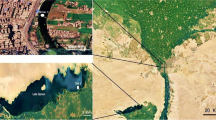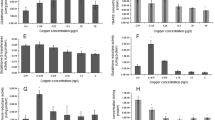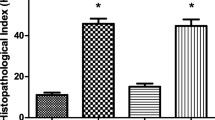Abstract
Vanadium (V) is a toxicant becoming increasingly concentrated in freshwater with the potential to affect aquatic organisms. Vanadium pentoxide (V2O5), accumulated in fish, can act as an oxidizing agent and cause oxidative damage. To determine the effects of V2O5 on exposed adult Oreochromis mossambicus, acute exposure experiments were conducted. Bioaccumulation and biomarker analyses were performed on various excised tissues of the exposed fish. As expected, accumulated V concentrations in the gills increased as the exposure concentration increased. Gill tissue accumulated more vanadium than muscle tissue. Metallothionein content increased in the highest concentrations compared to the lower concentrations, therefore showing that metallothionein proteins were attempting to sequester V2O5 in the tissues. Superoxide dismutase (SOD) showed an excitation at lower concentrations and inhibition as the exposure concentrations increased, possibly due to ROS detoxification. Catalase activity decreased from the first exposure concentration to the last concentration; this could have been due to SOD compensation. Protein carbonyl concentration decreased as the concentrations of V2O5 increased, indicating an inhibition of protein oxidation. The IBRv2 comparison revealed the biochemical responses caused by V2O5 more effectively than traditional statistical analysis.

Similar content being viewed by others
Data availability
The data for this manuscript are not currently publicly available but are available directly from the corresponding author on request.
Code availability
Not applicable.
References
Agency for Toxic Substances and Disease Registry (ATSDR) (1992) Toxicological profiles for vanadium. U.S. Department of Health and Human Services, Public Health Service, Atlanta, GA. Available from: https://www.atsdr.cdc.gov/toxprofiles/tp.asp?id=276&tid=50. Accessed 15 Nov 2018
Agency for Toxic Substances and Disease Registry (ATSDR) (2012) Toxicological profiles for vanadium. U.S. Department of Health and Human Services, Public Health Service, Atlanta, GA. Available from: https://www.atsdr.cdc.gov/toxprofiles/tp.asp?id=276&tid=50. Accessed 2 May 2019
Almroth BC, Sturve J, Stephensen E, Holth TF, Förlin L (2008) Protein carbonyls and antioxidant defenses in corkwing wrasse (Symphodus melops) from a heavy metal polluted and a PAH polluted site. Mar Environ Res 66(2):271–277. https://doi.org/10.1016/j.marenvres.2008.04.002
Amiard JC, Amiard-Triquet C, Barka S, Pellerin J, Rainbow PS (2006) Metallothioneins in aquatic invertebrates: their role in metal detoxification and their use as biomarkers. Aquat Toxicol 76(2):160–202. https://doi.org/10.1016/j.aquatox.2005.08.015
Amiard-Triquet C, Amiard JC, Rainbow PS (eds) (2013) Ecological biomarkers indicators of ecotoxicological effects. CRC Press, United States, pp 1–411
Atli G, Canli M (2008) Responses of metallothionein and reduced glutathione in a freshwater fish Oreochromis niloticus following metal exposures. Environ Toxicol Pharmacol 25:33–38. https://doi.org/10.1016/j.etap.2007.08.007
Azadmanesh J, Borgstahl GE (2018) A review of the catalytic mechanism of human manganese superoxide dismutase. Antioxidants 7(2):25. https://doi.org/10.3390/antiox7020025
Balamurugan M, Santharaman P, Madasamy T, Rajesh S, Sethy NK, Bhargava K, Kotamraju K, Srigiridhar K, Karunakaran C (2018) Recent trends in electrochemical biosensors of superoxide dismutases. Biosens Bioelectron 116:89–99. https://doi.org/10.1016/j.bios.2018.05.040
Beine K (2020) An investigation into the toxicity of vanadium pentoxide (V2O5) in Oreochromis mossambicus under laboratory exposure conditions. Unpublished MSc dissertation, University of Johannesburg, South Africa.
Beliaeff B, Burgeot T (2002) Integrated biomarker response: a useful tool for ecological risk assessment. Environ Toxicol Chem 21(6):1316–1322. https://doi.org/10.1002/etc.5620210629
Boss CB, Fredeen KJ (2004) Concepts, Instrumentation, and techniques in inductively coupled plasma optical emission spectrometry (2nd edition). Perkin Elmer, United States of America, pp 1–125
Bradford M (1976) A rapid and sensitive method for the quantification of microgram quantities of protein utilizing the principle of protein-dye binding. Anal Biochem 73:248–254. https://doi.org/10.1016/0003-2697(76)90527-3
Cambray J, Swartz E (2007) Oreochromis mossambicus. The IUCN Red List of Threatened Species 2007: e.T63338A12659743. https://doi.org/10.2305/IUCN.UK.2007.RLTS.T63338A12659743.en
Chan KM (1995) Metallothionein: Potential biomarker for monitoring heavy metal pollution in fish around Hong Kong. Mar Pollut Bull 31(4–12):411–415. https://doi.org/10.1016/0025-326X(95)00125-7
Cohen G, Dembiec D, Marcus J (1970) Measurement of catalase activity in tissue extracts. Anal Biochem 34:30–38. https://doi.org/10.1016/0003-2697(70)90083-7
Cohn VH, Lyle J (1966) A fluorometric assay for glutathione. Anal Biochem 14:434–440. https://doi.org/10.1016/0003-2697(66)90286-7
Dahms S, van der Bank FH, Greenfield R (2015) A baseline study of metal contamination along the Namibian coastline for Perna perna and Choromytilus meridionalis. Mar Pollut Bull 85:297–305. https://doi.org/10.1016/j.marpolbul.2014.05.037
Dahms-Verster S, Nel A, van Vuren JHJ, Greenfield R (2020) Biochemical responses revealed in an amphibian species after exposure to a forgotten contaminant: an integrated biomarker assessment. Environ Toxicol Pharmacol 73:1–9. https://doi.org/10.1016/j.etap.2019.103272
De Coen WM, Janssen CR (1997) The use of biomarkers in Daphnia magna toxicity testing. IV. Cellular energy allocation: a new methodology to assess the energy budget of toxicant-stressed Daphnia populations. J Aquat Ecosyst Stress Recovery 6:43–55. https://doi.org/10.1023/A:1008228517955
De Coen WM, Janssen CR (2003) The missing biomarker link: relationships between effects on the cellular energy allocation biomarker of toxicant-stressed Daphnia magna and corresponding population characteristics. Environ Toxicol Chem 22:1632. https://doi.org/10.1002/etc.5620220727
Del Maestro R, McDonald W (1989) Oxidative enzyme in tissue homogenates. In: Greenwald R (ed) CRC Handbook of Methods for Oxygen Radical Research, 4th edn. CRC Press, United States of America, pp 291–293
Del Caprio E, Hernandez L, Ciangherotti C et al (2018) Vanadium: history, chemistry, interactions with α-amino acids and potential therapeutic applications. Coord Chem Rev 372(2018):117–140
Department of Water Affairs and Forestry (DWAF) (1996) South African water quality guidelines, 2nd edn. Volume 8: Field Guide. The Government Printer, Pretoria, Republic of South Africa
Ellman GL, Courtney KD, Andres V, Featherstone RM (1961) A new and rapid colorimetric determination of acetylcholinesterase activity. Biochem Pharmacol 7:88–95. https://doi.org/10.1016/0006-2952(61)90145-9
Ezeonyeljaku CD, Ifedigbo II, Okoye CO, Ezenwelu CO (2019) Cellular energy budget in tropical freshwater fish following exposure to sblethal concenbtrations of cadmium. J Toxicol Environ Health Sci 11(7):75–83. https://doi.org/10.5897/JTEHS2019.0447
Fazio F, Saoca C, Sanfilippo M, Capillo G, Spanò N, Piccione G (2019) Response of vanadium bioaccumulation in tissues of Mugil cephalus (Linnaeus 1758). Sci Total Environ 689:774–780. https://doi.org/10.1016/j.scitotenv.2019.06.476
Fazio F, D’Iglio C, Capillo G, Saoca C, Peycheva K, Piccione G, Makedonski L (2020) Environmental investigations and tissue bioaccumulation of heavy metals in grey mullet from the Black Sea (Bulgaria) and the Ionian Sea (Italy). Animals 10(10):1739. https://doi.org/10.3390/ani10101739
Fernandes D, Zanuy S, Bebianno MJ, Porte C (2008) Chemical and biochemical tools to assess pollution exposure in cultured fish. Environ Pollut 152:138–146. https://doi.org/10.1016/j.envpol.2007.05.012
Field A (2009) Discovering statistics using SPSS, 3rd edn. Sage publications, London, pp 1–857
Floor E, Wetzel M (1998) Increased protein oxidation in human substantia nigra pars compacts in comparison with basal ganglia and prefrontal cortex measured with an improved dinitrophenylhydrazine assay. J Neurochem 70:268–275. https://doi.org/10.1046/j.1471-4159.1998.70010268.x
Gerber R, Smit NJ, van Vuren JHJ, Ikenaka Y, Wepener V (2018) Biomarkers in tigerfish (Hydrocynus vittatus) as indicators of metal and organic pollution in ecologically sensitive subtropical rivers. Ecotoxicol Environ Saf 157:307–317. https://doi.org/10.1016/j.ecoenv.2018.03.091
Henriksson J, Chi M, Hintz C, Young D, Kaiser K, Salmons S, Lowry O (1986) Chronic stimulation of mammalian muscle: changes in enzymes in six metabolic pathways. Am J Physiol Cell Physiol C251:614–632. https://doi.org/10.1152/ajpcell.1986.251.4.C614
Hilty J, Merenlender A (2000) Faunal indicator taxa selection for monitoring ecosystem health. Biol Conserv 92:185–197. https://doi.org/10.1016/S0006-3207(99)00052-X
Kivrak EG, Yurt KK, Kaplan AA, Alkan I, Altun G (2017) Effects of electromagnetic fields exposure on the antioxidant defence system. J Microsc Ultrastruct 5(4):167–176. https://doi.org/10.1016/j.jmau.2017.07.003
Kumar N, Krishnani KK, Meena KK, Gupta SK, Singh NP (2017) Oxidative and cellular metabolic stress of Oreochromis mossambicus as biomarkers indicators of trace element contaminants. Chemosphere 171:265–274
Landrum PF, Harkey GA, Kukkonen J (1996) Evaluation of organic contaminant exposure in aquatic organisms: the significance of bioconcentration and bioaccumulation. In: Newman MC, Jagoe CH (eds) Ecotoxicology: A hierarchal treatment. Lewis, Publishers, pp 84–85
Levene H (1960) Robust tests for equality of variances. In: Olkin I, Hotelling H et al (eds) Contributions to probability and statistics: essays in honor of Harold Hotelling. Stanford University Press. Palo Alto, CA, pp 278–292
Levine R, Garland D, Oliver C, Amici A, Climent I, Lenz A, Stadtman E (1990) Determination of carbonyl content in oxidatively modified proteins. Methods Enzymol 186:464–478. https://doi.org/10.1016/0076-6879(90)86141-h
Liu M, Guo H, Liu B, Zhu K, Guo L, Liu B, Zhang N, Yang J, Jiang S, Zhang D (2021) Gill oxidative damage caused by acute ammonia stress was reduced through the HIF-1α/NF-κb signaling pathway in golden pompano (Trachiton ovatus). Ecotoxicol Environ Saf 222:112504. https://doi.org/10.1016/j.ecoenv.2021.112504
Marchand MJ, van Dyk JC, Barnhoorn IEJ, Wagenaar DM (2012) Histological changes in two potential indicator fish species from a hyper-eutrophic freshwater ecosystem in South Africa: a baseline study. Afr J Aquat Sci 37:39–48. https://doi.org/10.2989/16085914.2011.636902
Martini FH, Nath JL, Bartholomew EF (2015) Fundamentals of anatomy & physiology, Tenth edition, England, Pearson Education Limited. pp. 69–354.
Moskalyk RR, Alfantazi AM (2003) Processing of vanadium: a review. Miner Eng 16:793–805. https://doi.org/10.1016/S0892-6875(03)00213-9
Muller WJ, Slaughter AR, Ketse N, Davies-coleman HD, Kock EDE, Palmer CG (2011) Development of chronic toxicity test methods for selected indigenous riverine macroinvertebrates (No. 1313/3/11). Water Research Commission. 978–1–4312–0167–9
Papadimitriou EA, Loumbourdis NS (2003) Copper kinetics and hepatic metallothionein levels in the frog Rana ridibunda, after exposure to CuCl2. Biometals 16:271–277. https://doi.org/10.1023/A:1020683404803
Parvez S, Raisuddin S (2005) Protein carbonyls: novel biomarkers of exposure to oxidative stress-inducing pesticides in freshwater fish Channa punctata (Bloch). Environ Toxicol Pharmacol 20:112–117. https://doi.org/10.1016/j.etap.2004.11.002
Phakgadi P (2019) Sasol intentionally polluted the Vaal River, SAHRC inquiry hears. Media 24, Cape Town South Africa. Available from: https://www.news24.com/SouthAfrica/News/sasol-intentionally-polluted-the-vaal-river-sahrc-inquiry-hears-20190221. Accessed 9 May 2019
Pretto A, Loro VL, Morsch VM, Moraes BS, Menezes C, Clasen B, Hoehne L, Dressler V (2010) Acetylcholinesterase activity, lipid peroxidation and bioaccumulation in silver catfish (Rhamdia quelen) exposed to cadmium. Arch Environ Contam Toxicol 58:1008–1014. https://doi.org/10.1007/s00244-009-9419-3
Rajeshkumar SA, Li X (2018) Bioaccumulation of heavy metals in fish species from the Meiliang Bay, Taihu Lake. China Toxicol Rep 5:288–295. https://doi.org/10.1016/j.toxrep.2018.01.007
Ray D, Banerjee SK, Chatterjee M (1990) Bioaccumulation of nickel and vanadium in tissues of the catfish Clarias batrachus. J Inorg Biochem 38:169–173. https://doi.org/10.1016/0162-0134(90)84010-M
Rehder D (2008) Bioinorganic vanadium chemistry. John Wiley & Sons, Ltd. The Atrium, Southern Gate, Chichester, West Sussex, England, p 224
Sanchez W, Burgeot T, Porcher J (2013) A novel “integrated biomarker response” calculation based on reference deviation concept. Environ Sci Pollut Res 20(5):2721–2725. https://doi.org/10.1007/s11356-012-1359-1
South African National Standards (SANS) (2008) South African National Standards for the care and use of animals for scientific purposes. Annexure N: SANS 10386:200X Edition 1. Standards South Africa, Groenkloof, Pretoria. pp 167.
Shapiro SS, Wilk MB (1965) An analysis of variance test for normality (complete samples). Biometrika 52(3–4):591–611. https://doi.org/10.2307/2333709
Shiau SY, Lin SF (1993) Effect of supplemental dietary chromium and vanadium on the utilization of different carbohydrates in tilapia Oreochromis Niloticus and o Aureus. Aquaculture 110(3–4):321–330. https://doi.org/10.1016/0044-8486(93)90379-D
Singh SM, Sivalingam PM (1982) In vivo study on the interactive effects on heavy metals on catalase activity of Sarotherodon mossambicus. J Fish Biol 20(6):683–688. https://doi.org/10.1111/j.1095-8649.1982.tb03978.x
Skelton P (2001) A complete guide to the freshwater fishes of Southern Africa. Struik Publishers, South Africa
Smolders R, De Boeck G, Blust R (2003) Changes in cellular energy budget as a measure of whole effluent toxicity in zebrafish (Danio rerio). Environ Toxicol Chem 22(4):890–899. https://doi.org/10.1002/etc.5620220429
Soares SS, Martins H, Gutiérrez-merino C, Aureliano M (2008) Vanadium and cadmium in vivo effects in teleost cardiac muscle: metal accumulation and oxidative stress markers. Comp Biochem Phys a 147:168–178. https://doi.org/10.1016/j.cbpc.2007.09.003
Stillman MJ (1995) Metallothioneins. Coord Chem Rev 144:461–511. https://doi.org/10.1016/0010-8545(95)01173-M
Tracey AS, Willsky GR, Takeuchi ES (2007) Vanadium chemistry, biochemistry, pharmacology and practical applications. Taylor and Francis Group, CRC Press, Boca Raton, pp 250. https://doi.org/10.1201/9781420046144
United States Environmental Protection Agency (USEPA) (2002) Methods for measuring the acute toxicity of effluents and receiving waters to freshwater and marine organisms (No. 821- R- 02–012). United States Environmental Protection Agency, Washington DC, United States of America, p 39
Uysal K, Emre Y, Köse E (2008) The determination of heavy metal accumulation ratios in muscle, skin and gills of some migratory fish species by inductively coupled plasma-optical emission spectrometry (ICP-OES) in Beymelek Lagoon (Antalya/Turkey). Microchem J 90:67–70. https://doi.org/10.1016/j.microc.2008.03.005
Van der Oost R, Beyer J, Vermeulen NPE (2003) Fish bioaccumulation and biomarkers in environmental risk assessment: a review. Environ Toxicol Pharmacol 13(2):57–149. https://doi.org/10.1016/S1382-6689(02)00126-6
Viarengo A, Ponzano E, Dondero F, Fabbri R (1997) A simple spectrophotometric method for metallothionein evaluation in marine organisms: an application to Mediterranean and Antarctic Molluscs. Mar Environ Res 44:69–84. https://doi.org/10.1016/S0141-1136(96)00103-1
Wang X, Wang L, Yao C, Qiu L, Zhang H, Zhi Z, Song L (2012) Fish & shell fish immunology alternation of immune parameters and cellular energy allocation of Chlamys farreri under ammonia-N exposure and Vibrio anguillarum challenge. Fish Shellfish Immunol 32(5):741–749
Weber D, Davies MJ, Grune T (2015) Redox biology determination of protein carbonyls in plasma, cell extracts, tissue homogenates, isolated proteins: focus on sample preparation and derivatization conditions. Redox Biol 5:367–380. https://doi.org/10.1016/j.redox.2015.06.005
Yang X (2018) Biology of vanadium-based compounds for treatment of diabetes. Elsevier Inc, Chemistry Molecular Sciences and Chemical Engineering
Acknowledgements
The authors would like to thank the University of Johannesburg for their financial contributions to this study in the form of the Global Excellence and Stature (GES) bursary. The authors would also like to put a note of acknowledgement for metal analysis done by SPECTRUM at the University of Johannesburg. We would also like to thank Mr. GR van Rensburg for his assistance with the IBRv2 analysis.
Funding
This project was supported by the University of Johannesburg Global Excellence and Stature with student bursary.
Author information
Authors and Affiliations
Contributions
KB, SD-V and RG contributed to the study conception and design. Material preparation, data collection and analysis were performed by KB. The first draft of the manuscript was written by KB and SD-V and RG commented on previous versions of the manuscript. KB, SD-V and RG read and approved the final manuscript.
Corresponding author
Ethics declarations
Ethics approval
This study was approved by the University of Johannesburg, Faculty of Science Ethics Committee, approval number 2019–04-15/Greenfield_Beine.
Consent to participate
Not applicable.
Competing interests
The authors declare no competing interests.
Additional information
Publisher's note
Springer Nature remains neutral with regard to jurisdictional claims in published maps and institutional affiliations.
Rights and permissions
Springer Nature or its licensor holds exclusive rights to this article under a publishing agreement with the author(s) or other rightsholder(s); author self-archiving of the accepted manuscript version of this article is solely governed by the terms of such publishing agreement and applicable law.
About this article
Cite this article
Beine, K., Dahms-Verster, S. & Greenfield, R. An integrated biomarker assessment of biochemical responses in a freshwater fish species after vanadium pentoxide (V2O5) exposure. Fish Physiol Biochem 48, 1221–1233 (2022). https://doi.org/10.1007/s10695-022-01113-0
Received:
Accepted:
Published:
Issue Date:
DOI: https://doi.org/10.1007/s10695-022-01113-0




